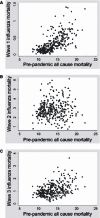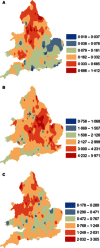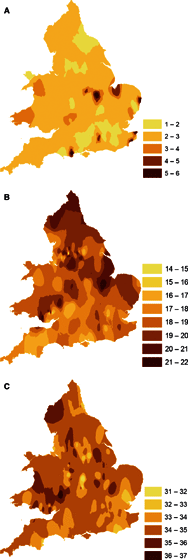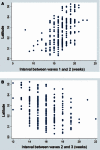Understanding mortality in the 1918-1919 influenza pandemic in England and Wales
- PMID: 21306572
- PMCID: PMC4954464
- DOI: 10.1111/j.1750-2659.2010.00186.x
Understanding mortality in the 1918-1919 influenza pandemic in England and Wales
Abstract
Background: The causes of recurrent waves in the 1918-1919 influenza pandemic are not fully understood.
Objectives: To identify the risk factors for influenza onset, spread and mortality in waves 1, 2 and 3 (summer, autumn and winter) in England and Wales in 1918-1919.
Methods: Influenza mortality rates for 333 population units and putative risk factors were analysed by correlation and by regressions weighted by population size and adjusted for spatial trends.
Results: For waves 1 and 3, influenza mortality was higher in younger, northerly and socially disadvantaged populations experiencing higher all-cause mortality in 1911-1914. Influenza mortality was greatest in wave 2, but less dependent on underlying population characteristics. Wave duration was shorter in areas with higher influenza mortality, typically associated with increasing population density. Regression analyses confirmed the importance of geographical factors and pre-pandemic mortality for all three waves. Age effects were complex, with the suggestion that younger populations with greater mortality in wave 1 had lesser mortality in wave 2.
Conclusions: Our findings suggest that socially disadvantaged populations were more vulnerable, that older populations were partially protected by prior immunity in wave 1 and that exposure of (younger) populations in one wave could protect against mortality in the subsequent wave. An increase in viral virulence could explain the greater mortality in wave 2. Further modelling of causal processes will help to explain, in considerable detail, how social and geographical factors, season, pre-existing and acquired immunity and virulence affected viral transmission and pandemic mortality in 1918-1919.
© 2010 Blackwell Publishing Ltd.
Figures

 , wave duration
, wave duration  and between‐wave intervals
and between‐wave intervals  for each of 333 administrative units. Source: Johnson 2001a & UK data Archive.
for each of 333 administrative units. Source: Johnson 2001a & UK data Archive.



References
-
- Smallman‐Raynor M, Johnson N, Cliff AD. The spatial anatomy of an epidemic: influenza in London and the county boroughs of England and Wales, 1918–1919. Trans Inst Br Geogr 2002; 27:452–470.
-
- Ministry of Health . Pandemic of Influenza 1918–9. Reports on Public Health and Medical Subjects No 4. London, England: His Majesty’s Stationery Office, 1920.
-
- Nicholson K, Webster R, Hay A. Textbook of influenza. Oxford: Blackwell Science, 1998.
Publication types
MeSH terms
LinkOut - more resources
Full Text Sources
Medical

